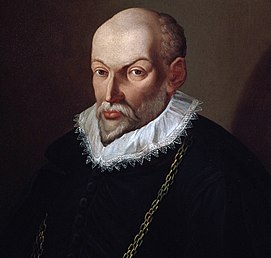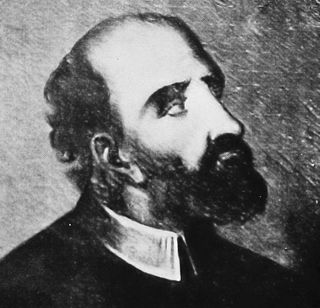A madrigale spirituale (Italian; pl. madrigali spirituali) is a madrigal, or madrigal-like piece of music, with a sacred rather than a secular text. Most examples of the form date from the late Renaissance and early Baroque eras, and principally come from Italy and Germany.

Renaissance music is vocal and instrumental music written and performed in Europe during the Renaissance era. Consensus among music historians has been to start the era around 1400, with the end of the medieval era, and to close it around 1600, with the beginning of the Baroque period, therefore commencing the musical Renaissance about a hundred years after the beginning of the Renaissance as it is understood in other disciplines. As in the other arts, the music of the period was significantly influenced by the developments which define the Early Modern period: the rise of humanistic thought; the recovery of the literary and artistic heritage of Ancient Greece and Ancient Rome; increased innovation and discovery; the growth of commercial enterprises; the rise of a bourgeois class; and the Protestant Reformation. From this changing society emerged a common, unifying musical language, in particular, the polyphonic style of the Franco-Flemish school, whose greatest master was Josquin des Prez.

Baroque music is a period or style of Western art music composed from approximately 1600 to 1750. This era followed the Renaissance music era, and was followed in turn by the Classical era. Baroque music forms a major portion of the "classical music" canon, and is now widely studied, performed, and listened to. Key composers of the Baroque era include Johann Sebastian Bach, Antonio Vivaldi, George Frideric Handel, Claudio Monteverdi, Domenico Scarlatti, Alessandro Scarlatti, Henry Purcell, Georg Philipp Telemann, Jean-Baptiste Lully, Jean-Philippe Rameau, Marc-Antoine Charpentier, Arcangelo Corelli, Tomaso Albinoni, François Couperin, Giuseppe Tartini, Heinrich Schütz, Giovanni Battista Pergolesi, Dieterich Buxtehude, and Johann Pachelbel.

Italy, officially the Italian Republic, is a European country consisting of a peninsula delimited by the Alps and surrounded by several islands. Italy is located in Southern Europe, and it is sometimes considered as part of Western Europe. The country covers a total area of 301,340 km2 (116,350 sq mi) and shares land borders with France, Switzerland, Austria, Slovenia, and the enclaved microstates of Vatican City and San Marino. Italy has a territorial exclave in Switzerland (Campione) and a maritime exclave in the Tunisian Sea (Lampedusa). With around 60 million inhabitants, Italy is the fourth-most populous member state of the European Union.
Madrigali spirituali were almost always intended for an audience of cultivated, often aristocratic amateurs. They were performed at private houses, academies, and courts of noblemen in Italy and adjacent countries, but almost certainly were not used liturgically. The madrigale spirituale was an a cappella form, though instrumental accompaniment was used on occasion, especially after 1600.
A cappella music is group or solo singing without instrumental accompaniment, or a piece intended to be performed in this way. The term "a cappella" was originally intended to differentiate between Renaissance polyphony and Baroque concertato style. In the 19th century, a renewed interest in Renaissance polyphony coupled with an ignorance of the fact that vocal parts were often doubled by instrumentalists led to the term coming to mean unaccompanied vocal music. The term is also used, albeit rarely, as a synonym for alla breve.
During the Counter-Reformation, there was, to some degree, a reaction against the secularization of the art of music in Italy, Spain and the southern (Catholic) portion of Germany. While that did not stop the composition of secular music (indeed, the explosion of forms and styles of secular music continued unabated), many composers began to adapt the most advanced secular compositional forms to religious usage. On occasion, existing madrigals were merely fitted with a religious text, usually in Latin, without any other change (such adaptations are called "contrafacta"). However, some of the madrigali spirituali reached heights of expressive and emotional intensity at least equal to that of the finest madrigalists in their secular compositions.

The Counter-Reformation, also called the Catholic Reformation or the Catholic Revival, was the period of Catholic resurgence that was initiated in response to the Protestant Reformation. It began with the Council of Trent (1545–1563) and largely ended with the conclusion of the European wars of religion in 1648. Initiated to preserve the power, influence and material wealth enjoyed by the Catholic Church and to present a theological and material challenge to Reformation, the Counter-Reformation was a comprehensive effort composed of apologetic and polemical documents, ecclesiastical reconfiguration as decreed by the Council of Trent, a series of wars, and political maneuvering. The last of these included the efforts of Imperial Diets of the Holy Roman Empire, exiling of Protestant populations, confiscation of Protestant children for institutionalized Catholic upbringing, heresy trials and the Inquisition, anti-corruption efforts, spiritual movements, and the founding of new religious orders. Such policies had long-lasting effects in European history with exiles of Protestants continuing until the 1781 Patent of Toleration, although smaller expulsions took place in the 19th century.

Spain, officially the Kingdom of Spain, is a European country located in Southwestern Europe with some pockets of Spanish territory across the Strait of Gibraltar and the Atlantic Ocean. Its continental European territory is situated on the Iberian Peninsula. Its territory also includes two archipelagoes: the Canary Islands off the coast of Africa, and the Balearic Islands in the Mediterranean Sea. The African enclaves of Ceuta, Melilla, and Peñón de Vélez de la Gomera make Spain the only European country to have a physical border with an African country (Morocco). Several small islands in the Alboran Sea are also part of Spanish territory. The country's mainland is bordered to the south and east by the Mediterranean Sea except for a small land boundary with Gibraltar; to the north and northeast by France, Andorra, and the Bay of Biscay; and to the west and northwest by Portugal and the Atlantic Ocean.
The form was probably encouraged by the Jesuits; some collections were dedicated to them, especially in the 1570s and 1580s.
Some famous examples of madrigali spirituali include Lassus's sublimely beautiful Lagrime di San Pietro (Munich, 1595); Guillaume Dufay's Vergine bella, (ca. 1470) setting a poem in praise of the Blessed Virgin Mary by Petrarch; Giovanni Pierluigi da Palestrina's First Book of Madrigals (1581), also setting Marian poems by Petrarch; Carlo Gesualdo's Tenebrae Responsories (1611); and the huge collection by Giovanni Francesco Anerio, Teatro armonico spirituale (Rome, 1619).

Orlande de Lassus was a composer of the late Renaissance, chief representative of the mature polyphonic style of the Franco-Flemish school, and considered to be one of the three most famous and influential musicians in Europe at the end of the 16th century.
The Lagrime di San Pietro is a cycle of 20 madrigals and a concluding motet by the late Renaissance composer Orlande de Lassus. Written in 1594 for seven voices, it is structured as three sequences of seven compositions. The Lagrime was to be Lassus’ last composition: he dedicated it to Pope Clement VIII on May 24, 1594, three weeks before his death, and it was published in Munich the next year.

Munich is the capital and most populous city of Bavaria, the second most populous German federal state. With a population of around 1.5 million, it is the third-largest city in Germany, after Berlin and Hamburg, and thus the largest which does not constitute its own state, as well as the 12th-largest city in the European Union. The city's metropolitan region is home to 6 million people. Straddling the banks of the River Isar north of the Bavarian Alps, it is the seat of the Bavarian administrative region of Upper Bavaria, while being the most densely populated municipality in Germany. Munich is the second-largest city in the Bavarian dialect area, after the Austrian capital of Vienna.






